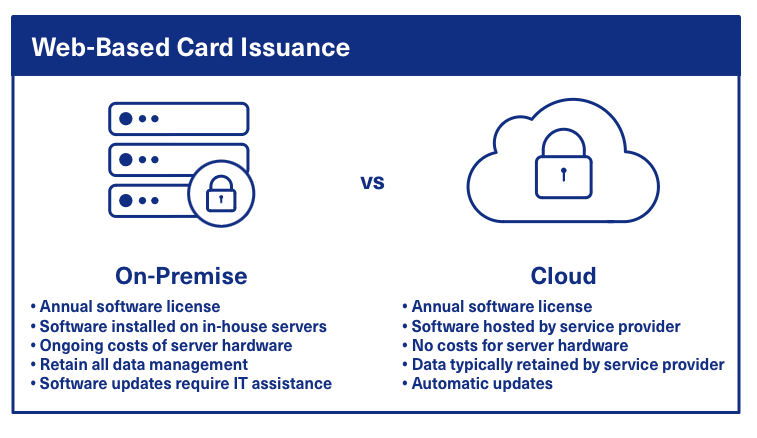
Written by Nils Wahlander, HID product marketer.
While we have seen a shift in users more readily migrating to cloud-based offerings, it is still quite common to have conversations with clients who share misconceptions about precisely what the cloud is, how it works and what options may be available.
Even those who have a baseline understanding of the cloud may still be mystified about how it can be applied to ID card issuance.
They also harbour apprehension specifically around security given the sensitivity of the information required to issue an ID card. All of this is entirely understandable.
Let’s attempt to demystify these concepts here.
Defining the cloud and recognising the benefits
In the simplest terms, cloud computing or “the cloud” is basically the web-enablement of computing services so that they may be accessed via the internet.
These services may include applications and/or the underlying technologies that support them such as operating systems, middleware, data storage, servers, networking and others.
To put it into relatable context, do you subscribe to a service to stream movies or television shows at home?
In the workplace, do you create and share documents using Microsoft® Office365®? If so, you’re using cloud technology.
Most of us use the cloud all day long without even realising it, but the benefits are obvious.
Not only are we free from having to download or manage software to access these services and applications, but also information is already conveniently synced among our devices — and we can access these cloud-based applications from anywhere be it our phone, laptop or television.
The flexibility is truly amazing.
Typically, cloud service or Software as a Service (SaaS) providers host some or all applications, computing services and systems on behalf of their customers.
The benefit is that the maintenance and management of applications, software and hardware are conveniently offloaded onto the service provider.
This saves their customers time and money — and allows them to allocate valuable resources elsewhere.
What Is an on-premise cloud solution?
You may have also heard the term “on-premise cloud.”
This term is used to describe a localised approach to cloud computing and differs from the typical cloud solutions described above.
With an on-premise cloud solution, users still experience all the flexibility benefits of the cloud in that the solution can be accessed from a browser and all data is synced.
The primary difference from a typical cloud implementation, however, is that the cloud service provider does not manage or maintain the servers on which the solution is stored.
These are instead managed by the provider’s customer. Another key difference is that because the solution is installed on the customer’s servers, users need to be on their company’s network to access the solution.

Image: HID
How does cloud-based ID card issuance work?
Creating an ID card typically starts with a personal computer (PC) connected to a card printer within arm’s reach.
The process includes the designing of a card template, management of the ID records using a networked database and then sending the card to the printer.
With the advent of true cloud-based platforms, this entire process can now be managed remotely and without the need for a dedicated PC.
With a cloud-based model, everything required for the secure issuance of an ID card is located within a centralised and integrated system that can be accessed via the internet by an administrator in a card office at a main campus location, satellite facility or remote location such as your home office.
Using cloud technology, new cards can be created (including the management of smart data and encoding during the print process), replacements can be issued and print queues can be managed — all from a tablet, laptop or any device with a web interface.
Most impressive is the scalability of this model, as users can add or remove devices from which to issue cards without ever having to install any software – including cumbersome Windows® print drivers which often require frequent updating.
What should I look for in a cloud-based ID Card issuance solution?
First and foremost, you’ll want to seek out providers that offer seamless integration with the systems from which ID card data will be derived.
Seamless technology partner integration not only reduces card office complexities, but it also streamlines the operator experience as card issuers are no longer required to toggle back-and-forth between a record management application (such as an access control solution) and a separate card issuance application.
More broadly, organisations can also eliminate multiple layers of program costs, gain issuance process efficiencies and easily scale the card office to accommodate future technology or volume demands.
Beyond integration, you’ll want to look for solutions that have a multi-layered approach to security as opposed to those that rely on only a single approach or mechanism for data security.
While most secure cloud products rely solely on a Transport Layer Security (TLS) connection to provide data security, industry-leading solutions such as HID® FARGO® Connect™ utilises TLS for communications in addition to mutual TLS authentication and end-to-end asymmetric RSA data encryption. This multi-layered approach ensures that card holder data — in transit and at rest — is always secured.






